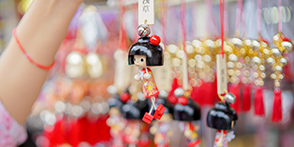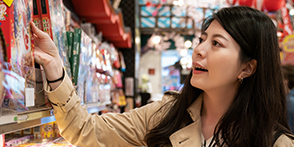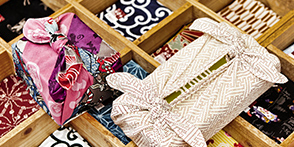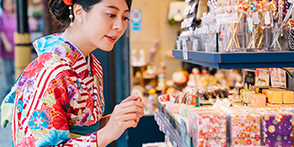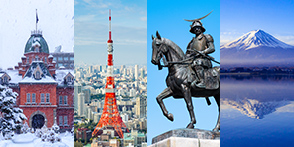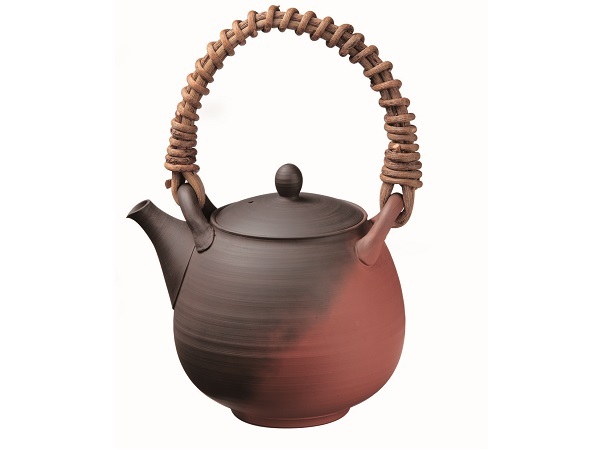- TOP
- Search
- Products Search results
- Aichi [Ceramics] TOKONAME Yaki (Pottery)
Aichi [Ceramics] TOKONAME Yaki (Pottery)
- Categories
- Art / Traditional crafts
- Area
- Tokai Aichi
- Shops
- Traditional Crafts Aoyama Square
- Update date
- 2023-01-06
Pieces representing the beginnings of Tokoname Yaki were made at the end of the Heian period (794-1185) and it is now counted among Japan's six old kilns. During the Heian period, Kyozuka urns were made in which to put Buddhist sutras before burial in the ground as a way of asking favors of the Buddha. During the Muromachi period (1392-1573), the pottery produced mainly tea bowls and other tea ceremony items as well as ikebana flower vases. Jars appeared in the middle of the Edo period (1600-1868) and normal household tableware started to be produced at the end of the Edo period alongside the prized tea ceremony pieces. Sanitary items such as drain-pipes, wash-hand basin and toilets, tiles and plant pots were added to the list of products in the Meiji period (1868-1912). Undoubtedly the vast range of products available today is the result of being a production center with plentiful supplies of good quality clay to hand, and because of the area's ability to change its line of main products in step with demand down through history.
The red coloring which develops as a result of the iron in the clay is a special feature of this ware, and while some of the pieces develop the qualities of the clay to the full, others are glaze. The product line is mainly composed of traditional items including items for tea ceremony use, vases, ornaments, decorative plant pots, bonsai trays, and an assortment of jars and larger pots.
Related products
-
- Art / Traditional crafts
Kyoto 〔Textiles/Weaving〕 NISHIJIN Ori (Textiles)
Kansai Kyoto
Traditional Crafts Aoyama Square
-
- Art / Traditional crafts
Tokushima [Textiles/Weaving] AWA Shoai Shijira Ori (Indigo-dyed Cotton Textiles)
Shikoku Tokushima
Traditional Crafts Aoyama Square
-
- Art / Traditional crafts
Tokyo [Textiles/Dyeing] TOKYO Tegaki Yuzen (Dyeing)
Kanto Tokyo
Traditional Crafts Aoyama Square
-
- Art / Traditional crafts
Kyoto [Textiles/Dyeing] KYO Kanoko Shibori (Tie-Dyeing)
Kansai Kyoto
Traditional Crafts Aoyama Square
-
- Art / Traditional crafts
Ibaraki [Ceramics] KASAMA Yaki (Pottery)
Kanto Ibaraki
Traditional Crafts Aoyama Square
-
- Art / Traditional crafts
Tochigi [Ceramics] MASHIKO Yaki (Pottery)
Kanto Tochigi
Traditional Crafts Aoyama Square
-
- Art / Traditional crafts
Ishikawa [Ceramics] KUTANI Yaki (Porcelain)
Hokuriku-Shinetsu Ishikawa
Traditional Crafts Aoyama Square
-
- Art / Traditional crafts
Mie [Ceramics] YOKKAICHI BANKO Yaki (Ceramics)
Tokai Mie
Traditional Crafts Aoyama Square
-
- Art / Traditional crafts
Kyoto[Ceramics] KYO-KIYOMIZU Yaki (Ceramics)
Kansai Kyoto
Traditional Crafts Aoyama Square
-
- Art / Traditional crafts
Okayama [Ceramics] BIZEN Yaki (Pottery)
Chugoku Okayama
Traditional Crafts Aoyama Square
-
- Art / Traditional crafts
Ehime [Ceramics] TOBE Yaki (Porcelain)
Shikoku Ehime
Traditional Crafts Aoyama Square
-
- Art / Traditional crafts
Fukuoka [Ceramics] KOISHIWARA Yaki (Pottery)
Kyushu Fukuoka
Traditional Crafts Aoyama Square
-
- Art / Traditional crafts
Saga [Ceramics] IMARI-ARITA Yaki (Porcelain)
Kyushu Saga
Traditional Crafts Aoyama Square
-
- Art / Traditional crafts
Nagasaki [Ceramics] HASAMI Yaki (Porcelain)
Kyushu Nagasaki
Traditional Crafts Aoyama Square
-
- Art / Traditional crafts
Kagoshima [Ceramics] SATSUMA Yaki (Ceramics)
Kyushu Kagoshima
Traditional Crafts Aoyama Square
-
- Art / Traditional crafts
Aomori [Lacquer Ware] TSUGARU Nuri (Lacquerware)
Tohoku Aomori
Traditional Crafts Aoyama Square
-
- Art / Traditional crafts
Iwate [Lacquer Ware] JOBOJI Nuri (Lacquerware)
Tohoku Iwate
Traditional Crafts Aoyama Square
-
- Art / Traditional crafts
Akita [Lacquer Ware] KAWATSURA Shikki (Lacquerware)
Tohoku Akita
Traditional Crafts Aoyama Square
-
- Art / Traditional crafts
Fukushima [Lacquer Ware] AIZU Nuri (Lacquerware)
Tohoku Fukushima
Traditional Crafts Aoyama Square
-
- Art / Traditional crafts
Kanagawa [Lacquer Ware] KAMAKURA Bori (Wood Carvings and Lacquerware)
Kanto Kanagawa
Traditional Crafts Aoyama Square
-
- Art / Traditional crafts
Niigata [Lacquer Ware] MURAKAMI Kibori Tsuishu (Wood Carvings and Lacquerware)
Hokuriku-Shinetsu Nigata
Traditional Crafts Aoyama Square
-
- Art / Traditional crafts
Nagano [Lacquer Ware] KISO Shikki (Lacquerware)
Hokuriku-Shinetsu Nagano
Traditional Crafts Aoyama Square
-
- Art / Traditional crafts
Toyama [Lacquer Ware] TAKAOKA Shikki (Lacquerware)
Hokuriku-Shinetsu Toyama
Traditional Crafts Aoyama Square
-
- Art / Traditional crafts
Ishikawa [Lacquer Ware] WAJIMA Nuri (Lacquerware)
Hokuriku-Shinetsu Ishikawa
Traditional Crafts Aoyama Square
-
- Art / Traditional crafts
Ishikawa [Lacquer Ware] YAMANAKA Shikki (Lacquerware)
Hokuriku-Shinetsu Ishikawa
Traditional Crafts Aoyama Square
-
- Art / Traditional crafts
Gifu [Lacquer Ware] HIDA Shunkei (Lacquerware)
Tokai Gifu
Traditional Crafts Aoyama Square
-
- Art / Traditional crafts
Fukui [Lacquer Ware] ECHIZEN Shikki (Lacquerware)
Hokuriku-Shinetsu Fukui
Traditional Crafts Aoyama Square
-
- Art / Traditional crafts
Fukui [Lacquer Ware] WAKASA Nuri (Lacquerware)
Hokuriku-Shinetsu Fukui
Traditional Crafts Aoyama Square
-
- Art / Traditional crafts
Wakayama [Lacquer Ware] KISHU Shikki (Lacquerware)
Kansai Wakayama
Traditional Crafts Aoyama Square
-
- Art / Traditional crafts
Yamaguchi [Lacquer Ware] OUCHI Nuri (Lacquerware)
Chugoku Yamaguchi
Traditional Crafts Aoyama Square
-
- Art / Traditional crafts
Kagawa [Lacquer Ware] KAGAWA Shikki (Lacquerware)
Shikoku Kagawa
Traditional Crafts Aoyama Square
-
- Art / Traditional crafts
Akita [Wood craft] Kaba Zaiku (Cherry Bark Work)
Tohoku Akita
Traditional Crafts Aoyama Square
-
- Art / Traditional crafts
Kanagawa [Wood craft] HAKONE Yosegi Zaiku (Marquetry Wood Mosaics)
Kanto Kanagawa
Traditional Crafts Aoyama Square
-
- Art / Traditional crafts
Osaka [Wood craft] OSAKA Karaki Sashimono (Joinery)
Kansai Osaka
Traditional Crafts Aoyama Square
-
- Art / Traditional crafts
Shizuoka [Bamboo craft] SURUGA Take Sensuji Zaiku (Bamboo Latticeware)
Tokai Shizuoka
Traditional Crafts Aoyama Square
-
- Art / Traditional crafts
Oita [Bamboo craft] BEPPU Take Zaiku (Bamboo Basketry)
Kyushu Oita
Traditional Crafts Aoyama Square
-
- Art / Traditional crafts
Iwate [Metalwork] NAMBU Tekki (Cast Ironwork)
Tohoku Iwate
Traditional Crafts Aoyama Square
-
- Art / Traditional crafts
Tokyo [Metalwork] TOKYO Ginki (Silversmithing)
Kanto Tokyo
Traditional Crafts Aoyama Square
-
- Art / Traditional crafts
Niigata [Metalwork] TSUBAME Tsuiki Doki (Beaten Copperware)
Hokuriku-Shinetsu Nigata
Traditional Crafts Aoyama Square
-
- Art / Traditional crafts
Toyama [Metalwork] TAKAOKA Doki (Bronze Casting)
Hokuriku-Shinetsu Toyama
Traditional Crafts Aoyama Square
-
- Art / Traditional crafts
Fukui [Metalwork] ECHIZEN Uchihamono (Forged Blades)
Hokuriku-Shinetsu Fukui
Traditional Crafts Aoyama Square
-
- Art / Traditional crafts
Osaka [Metalwork] SAKAI Uchihamono (Forged Blades)
Kansai Osaka
Traditional Crafts Aoyama Square
-
- Art / Traditional crafts
Osaka [Metalwork] OSAKA NANIWA Suzuki (Pewterware)
Kansai Osaka
Traditional Crafts Aoyama Square
-
- Art / Traditional crafts
Hyogo [Metalwork] BANSHU MIKI Uchihamono (Forged Blades)
Kansai Hyogo
Traditional Crafts Aoyama Square
-
- Art / Traditional crafts
Kumamoto [Metalwork] HIGO Zogan (Inlay)
Kyushu Kumamoto
Traditional Crafts Aoyama Square
-
- Art / Traditional crafts
Yamanashi [Semiprecious Stone Craftwork] KOSHU Suisho Kiseki Zaiku (Crystal Carving)
Tokai Yamanashi
Traditional Crafts Aoyama Square
-
- Art / Traditional crafts
Aichi [Writing Tools] TOYOHASHI Fude (Brushes)
Tokai Aichi
Traditional Crafts Aoyama Square
-
- Art / Traditional crafts
Nara [Writing Tools〕 NARA Fude (Brushes)
Kansai Nara
Traditional Crafts Aoyama Square
-
- Art / Traditional crafts
Hiroshima [Writing Tools] KUMANO Fude (Brushes)
Chugoku Hiroshima
Traditional Crafts Aoyama Square
-
- Art / Traditional crafts
Hiroshima [Writing Tools] KAWAJIRI Fude (Brushes)
Chugoku Hiroshima
Traditional Crafts Aoyama Square
-
- Art / Traditional crafts
Miyagi [Writing Tools] OGATSU Suzuri (Inkstones)
Tohoku Miyagi
Traditional Crafts Aoyama Square
-
- Art / Traditional crafts
Yamaguchi [Writing Tools] AKAMA Suzuri (Inkstones)
Chugoku Yamaguchi
Traditional Crafts Aoyama Square
-
- Art / Traditional crafts
Yamagata [Other Crafts] TENDO Shogi Koma (Japanese Chess Pieces)
Tohoku Yamagata
Traditional Crafts Aoyama Square
-
- Art / Traditional crafts
Aichi [Other Crafts] OWARI Shippo (Cloisonné)
Tokai Aichi
Traditional Crafts Aoyama Square
-
- Art / Traditional crafts
Tokyo [Other Crafts] EDO Kiriko (Cut Glasses)
Kanto Tokyo
Traditional Crafts Aoyama Square
-
- Art / Traditional crafts
Tokyo [Other Crafts] EDO Glass (Glassware)
Kanto Tokyo
Traditional Crafts Aoyama Square
-
- Art / Traditional crafts
Yamanashi [Other Crafts] KOSHU Inden (Lacquered Deerskin Crafts)
Tokai Yamanashi
Traditional Crafts Aoyama Square
-
- Art / Traditional crafts
Ishikawa [Materials and Tools for Making Crafts] KANAZAWA Haku (Gold Leafs)
Hokuriku-Shinetsu Ishikawa
Traditional Crafts Aoyama Square
-
- Art / Traditional crafts
Saitama Tokyo [Dolls] EDO Kimekomi Ningyo (Dolls)
Kanto Tokyo
Traditional Crafts Aoyama Square
-
- Art / Traditional crafts
Saitama Tokyo 〔Dolls and Kokeshi〕 Iwatsuki Ningyo
Kanto Tokyo
Traditional Crafts Aoyama Square
-
- Others
(Miyagi )Traditional Kokeshi dolls
Tohoku Miyagi
Traditional Crafts Aoyama Square
